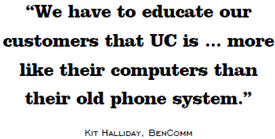How The Telephony Revolution Can Boost Your Revenue
By Gennifer Biggs, Business Solutions Magazine
The integration of mobile and cloud technologies with UC (unified communications) is driving strong growth for this solutions provider.

Exciting. That’s the word most often used by Kit Halliday, VP and chief technology officer for BenComm, as he talks about the revolution underway in the telephony space. As a solutions provider with more than 20 years in the unified communications (UC) industry, BenComm has watched telephony evolve to encompass some of today’s most cutting-edge technologies, namely mobile and cloud. The company has found success by staying one step ahead of the trends — but it hasn’t been easy.
What To Expect When Combining Mobile, UC Solutions
For BenComm, the mobile phenomenon wasn’t much of a shock. The company had been working with mobile collaboration technology since the late ’90s, guiding many of its customers toward the convergence of mobile and UC well before the mobile buzz fully hit the market. “We found those technologies and features that we thought were exciting and that helped us transform the way we did business, and then we shared that insight with our clients,” says Halliday. He cites the one-number dial feature, telepresence, and mobile applications that empower integrated use of smartphones and tablets as some examples of those mobile collaboration tools. Halliday adds that the combination of UC and mobility came more naturally for BenComm than, say, adding cloud services, which required a whole new level of expertise.
To stay flush with the mobile trends being pushed quickly forward by consumerism, BenComm relies on guidance from its vendor and distribution partners as well as peer groups. For instance, new collaboration solutions for devices such as tablets, which further connect BenComm’s clients with offices and customers, are hot these days. As a result, the company is currently working with Avaya’s Flare Communicator, a new collaboration software for iPads.
One of the challenges with selling mobile collaboration technology is delivering not only what the customer needs, but also what they are actually ready to use. “We have learned to bring a lot of options to each customer, and then let them guide us to what their true needs are. But we also try not to overwhelm them,” says Halliday. The most common hurdles during sales conversations arise when a customer is simply unsure about a new technology or has had a bad experience with that technology. Typically, BenComm addresses those reservations by offering a couple of free licenses so the client can test drive the technology before making a decision.
According to Halliday, those decision makers typically have two approaches: they are slow to adopt, layering on mobility tools piece by piece so as not to overwhelm the end users, or they feel obligated to push their workforce toward improved productivity and collaboration, even if it means some users are a bit out of their comfort zones. BenComm uses its expertise to help its clients choose which path is the right one for their needs, but he warns that this consultative part of the process creates a longer sales cycle than some other technologies. “Customers have to be educated about the potential mobile solutions that are available before you can walk them through the process of determining which solutions are right for their business culture,” he explains.
Test Your Mobile Collaboration Tools On Your Company First
When asked why mobile collaboration seems to be gaining in popularity, Halliday explains that, unlike past telephony advances, mobile collaboration actually simplifies the end user experience. That means the barriers to adoption have decreased rather that increased with modern technology. “Mobile collaboration really has become idiot proof,” says Halliday. “We used to have to train and train when we were dealing with traditional PBX systems; it could be quite cumbersome. Today, with collaboration, if it rings, answer it. Regardless of the device — smartphone, iPad, or desk phone — you just have to answer it. It can’t be easier than that.”
In fact, Halliday notes that mobile communications are so easy to learn that BenComm tests new solutions with the entire staff. “We have everyone from the admin staff to techs to sales use these tools,” he explains. The solutions provider relies on UC solutions, ranging from the call center software it sells to mobile collaboration in every form. That daily use serves a couple of purposes. One, it helps the sales and technical teams learn the details of the solutions they sell and support. Clearly, it is easier to talk with a customer about a technology with which you have personal experience, whether in a sales setting or while troubleshooting a problem. Second, Halliday says using the technology is also a good opportunity to identify potential issues with a solution before BenComm rolls it out to a customer. “We understand that our own points of conflict are likely to pop up in customer environments,” says Halliday.
Are You Missing Cloud Telephony Sales?
The situation around the convergence of cloud and telephony is entirely different for BenComm, which is still evaluating cloud technology in terms of how and where it is a fit for the solutions provider’s customer base. Unlike mobile collaboration, BenComm wasn’t entirely prepared for hosted telephony. In fact, several customers adopted a solution without even consulting the solutions provider. “It wasn’t until our customers came to us that we started to address the issue,” explains Halliday. He quickly realized that the cloud services providers peddling hosted telephony often already had a toehold in BenComm’s customers’ environments. “Those vendors were already in our sites, perhaps providing Internet or some other solution that we didn’t touch, and that gave them the inside track for the telephony sell,” explains Halliday.

While BenComm moved quickly to evaluate cloud telephony options, it took nearly nine months of research to identify the right solution for its customers. “We not only picked the right solution for us, we ended up understanding a lot about the technology and where it is going,” he adds. One lesson: with BenComm’s background with premised-based telephony, the company was used to asking about the feature set of a telephony solution first and foremost. Today, the solutions provider understands that the value of cloud is more about ease of deployment — no up-front Capex investment and one easy bill. “Once we understood the market value, we had a much easier time determining our approach to cloud,” says Halliday.
For BenComm, that solution is geared less toward its enterprise and midmarket clients and more toward its SMB customers. “We found that for now, with the state of cloud telephony, small businesses are a good fit because they are less concerned about a rich feature set, and the cost savings are enough to offset other issues,” explains Halliday. So far, the ideal client has 2 to 10 employees and is simply too small to afford a premise-based solution. While BenComm remains vigilant, watching the market for cloud telephony solutions that are slowly maturing to meet the needs of enterprise clients, Halliday says he expects that evolution to take a couple more years.
Converging Telephony Tech Helps Drive Growth
So far, BenComm’s new forays into mobile and cloud technologies have fueled growth. In the last few years, the company has seen revenue growth of nearly 16% year over year — with some fluctuations due to project work tied to BenComm’s ongoing dedication to on-premise telephony. However, mobile, in particular, has been a large part of that upward trajectory, and BenComm’s average growth is on an upswing tightly linked to the recurring revenue of mobile deployments. “We used to do discovery to see if mobile was of interest to our customers. Today, we know mobile will be an element of every sale,” explains Halliday. His advice for solutions providers preparing to mesh mobile with a more traditional UC line card is simply about education. “We have to educate our customers that UC is now an evolving technology, more like their computers than their old phone system, and therefore, we need to revisit it more often,” he says. “We also have to re-educate our customers about the role we can play — that is essential to success.”
He expects that as mobile telephony gains more traction with the ongoing adoption of bring your own device (BYOD) policies, sales will continue to increase. And, as cloud telephony matures to the point it can compete featureto- feature in more customer environments, BenComm expects to reap the benefits of that adoption trend as well.

